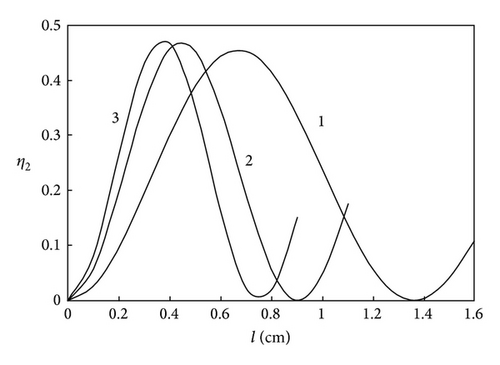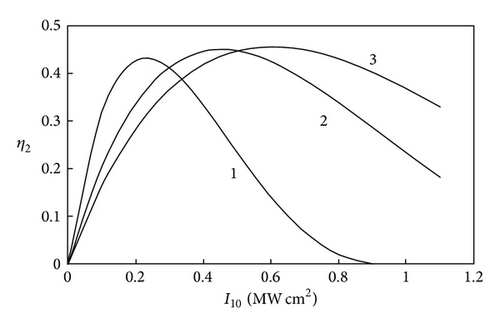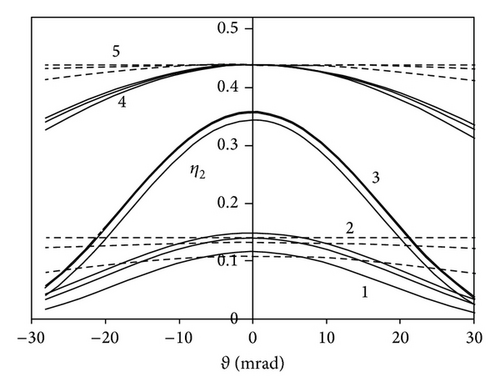Second Harmonic of Laser Radiation for IR-Range in Mixed AgGa0.6In0.4Se2 Crystals
Abstract
The results of investigations of the influence of different parameters on conversion efficiency in mixed AgGa0.6In0.4Se2 crystal in conditions of existing experiments are cited. The angular dispersion coefficients for three versions of crystal AgGaxIn1−xSe2, differing by a content of indium, have been calculated. A comparison was made of the obtained results on conversion efficiency with analogous results in case of other crystals and with corresponding experimentally measured values. The applied analytical method makes it possible to calculate the optimum parameters of both crystal-converter and a source of radiation for conditions of uncritical phase matching in the concrete experiment.
1. Introduction
Recently, the important achievements have been attained in application of nonlinear crystals in the numerous devices of IR-range. One can note among them the prospect CdGeAs2 crystals, available ZnGeP2 crystals, AgGaSe2, and others [1–3]. Selection of nonlinear crystals is determined by requirement of obtaining the high conversion efficiency of pump radiation in a tuning wide spectral range. As one way of solving this problem, it is suggested to use chalcogenide crystals or chalcopyrite structures, for example, AgGaxIn1−xSe2, AgGa(Se1−xSx) 2 [2]. In similar crystals, by changing parameter x, it is possible to realize uncritical 90° phase matching. This condition ensures the absence of walk-off of second harmonic energy, excluding decrease of second harmonic generation caused by birefringence.
We have chosen the perspective crystals AgGaxIn1−xSe2 as a subject of study among crystals of mixed type, owing to a number of its qualities. As showed in the result of experiment [4] by researchers, by choosing indium content, it is possible to perform the uncritical condition of 90° phase matching at second harmonic generation in near and middle IR-range. With this, a value of parameters x on wavelength of CO2 laser radiation λ = 9.64 mcm is equal to 0.6. The measured value of quadratic nonlinear susceptibility for AgGa0.6In0.4Se2 crystal is equal to d36 = 41 pm/V [4]. For comparison, the analogous specified value for AgGaSe2 crystal is equal to 39 pm/V [3, 4].
For the task of application in IR-range of spectrum CO2 lasers (which present a powerful source of optical coherent radiation in the given region of spectrum) play a leading role. If in the middle IR-region of spectrum an efficient generation of radiation for this laser permits realizing tunable coherent radiation, then in the near IR-range it can succeed owing to radiation of second harmonics for CO2 laser.
To consider a wide circle of the tasks in a theory for nonlinear waves, it is necessary to solve the system of coupled nonlinear differential equations. In most cases, solution of such system in a general form is not possible, so to analyze the complete system of reduced equation, different approximation methods have been used. Among them, constant-field approximation of basic radiation was widely used [5–7]. In this approximation, both the real amplitude and phase for wave are considered to be constant. The constant-field approximation depicts rightly only an initial stage of nonlinear interaction for waves until it is not generally possible to take into account the reverse reaction of generated or enforced waves to the intense pump wave. This leads to restricted consideration of wave interaction in real media and loss of information on features of the nonlinear process.
For analyzing of nonlinear process, it is possible to use the direct calculation of coupled equations. However, development of the analytical method will permit receiving the concrete analytical expressions and defining optimum parameters of the task for the purpose of obtaining the maximum efficiency of conversion.
To study the nonlinear optical properties of selected type of crystal, it is expedient to resort to the constant-intensity approximation [8, 9], enabling to take into regard an impact of excited wave on exciting one. The given approximations permitted considering an influence of phase effects on the process of redoubling CO2 laser radiation frequency in these crystals of mixed type.
In this paper the influence of different parameters of task on conversion efficiency in AgGa0.6In0.4Se2 crystal has been investigated in conditions of existing experiments. The angular dispersion coefficients have been calculated for three versions of AgGaxIn1−xSe2 crystals, differing by content of indium. Comparison of received result on conversion efficiency has been made with analogous result in case of other crystals and with corresponding experimentally measured values. The ways of increasing conversion efficiency are displayed. The used analytical method permits calculating optimum parameters of both crystal-converter and radiation source for conditions of uncritical phase match in the concrete experiment. Thus, for example, we can calculate optimal crystal length at the given losses and the pump intensities, which allows one to estimate expected conversion efficiency.
2. Theory
Let us analyze the process of redoubling the frequency of CO2 laser radiation (at frequency ω1) in AgGaxIn1−xSe2 negative uniaxial crystal in case of oo → e scalar phase matching for first type.
System (1) does not include the members that are responsible for thermal effects. In the present work the investigation of frequency conversion for low value of pump intensity is explained.
From (3) it is seen that the harmonic amplitude depending on length is a periodic function. At first, at the optimal length (coherent length) transferring of basic radiation energy to the second harmonic energy happens. Then a reverse transfer of energy occurs. From (3) at δ2 = 2δ1 it is possible to receive optimum length of crystal. At this length in the process of frequency conversion, a harmonic signal is maximum , where . Whence it appears that in this case, in contrast to the results of the constant-field approximation, a coherent length of nonlinear medium depends on pump intensity I10 and dissipation in a medium. By increasing in pump intensity and mismatch, the optimum length decreases. When we ignore the losses [8, 9].
At γ1 = 0 and δj = 0 from (3) we have an expression for conversion efficiency in the constant-field approximation.
An important requirement for the efficient proceeding nonlinear optical process is the necessity of fulfillment of optimum phase correlation between interacting waves. The violation of this condition leads to mismatch of waves phase and, as a consequence, to decrease of conversion frequency efficiency. One of the basic reasons that cause break of condition of optimum phase correlation is the phase mismatch. At frequency conversion in the conditions of phase mismatch, it is impossible to fulfill the complete transfer of basic radiation energy to second harmonic energy. In this case the spatial beatings of harmonic amplitudes are observed. This time, the minimums of harmonic intensity beatings, as an analysis shows in the constant-intensity approximation, depend on nonlinear susceptibilities of crystal [10]. This fact permits defining the nonlinear susceptibilities of substances by a simple way, more precise than in the constant-field approximation. With an increase in phase mismatch, spatial frequency increases, but at this time, maximum value of second harmonic intensity decreases.
In the experiment for real frequency converters, it is impossible to ensure a condition of phase agreement, that is, phase matching (Δ = 0). An error in following the condition of phase matching determines the width of phase matching. Spectral width of pump radiation line, deviation from phase matching angle due to divergence of laser radiation, and instability of temperature for a crystal converter all contribute to mismatch. Hence receiving information, in particular, on angular width of phase matching, will permit calculating the maximum divergence of light beam for pumping. Moreover, determination of conditions for realizing uncritical phase matching at chosen length of pump wave is important for exclusion of taking down the influence of birefringent walk-off on generation efficiency. This fact allows one to take away the restriction of length of the used crystals [4, 7, 11].
Let us define an angular width of phase matching in uniaxial crystal for mixed type AgGaxIn1−xSe2 in case of second harmonic generation of CO2 laser radiation on three wavelengths of pump: 9.64 mcm, 9.55 mcm, and 9.31 mcm (scalar phase matching of the first type for oo → e interaction). We will carry out the calculation of deviation angle from the direction of phase matching Δθ according to [7] for three values reflecting indium content in crystal (0, 0.3, and 0.4). With this, Sellmeier coefficients were used cited in [4, 12].
The results of calculations are presented for angular dispersion coefficient of the first and second orders in Table 1.
| Crystal | λ, mcm | d36, pm/V | Phase matching type | ϑs, degree | Angular dispersion coefficient of first order, cm−1·ang·min.−1 | ||||
|---|---|---|---|---|---|---|---|---|---|
| AgGaSe2 | 9.31 | 2.597798 | 2.565611 | 2.616307 | 2.58463 | 39.0 [11] | oo → e |
|
0.048353 |
| AgGaSe2 | 9.55 | 2.596647 | 2.563607 | 2.616158 | 2.584178 | 39.0 [11] | oo → e |
|
0.047611 |
| AgGaSe2 | 9.64 |
|
2.563902 | 2.615704 |
|
39.0 [11] | oo → e |
|
0.046432 |
| AgGa0.7In0.3Se2 | 9.31 | 2.606749 | 2.584379 | 2.624120 | 2.602546 | 40.6 [4] | oo → e | 63.5 [4] | 0.026456 |
| AgGa0.7In0.3Se2 | 9.55 | 2.583259 | 2.605674 | 2.623659 | 2.602059 | 40.6 [4] | oo → e | 65.0 [4] | 0.024782 |
| AgGa0.7In0.3Se2 | 9.64 | 2.605264 | 2.582832 | 2.623489 | 2.60188 | 40.6 [4] | oo → e | 66.0 [4] | 0.023831 |
| AgGa0.6In0.4Se2 | 9.31 | 2.609726 | 2.590959 | 2.626858 | 2.608989 | 41.0 [14] | oo → e | 77.6 [4] | 0.011648 |
| AgGa0.6In0.4Se2 | 9.55 | 2.609726 | 2.589858 | 2.626432 | 2.608496 | 41.0 [14] | oo → e | 83.4 [4] | 0.006216 |
| Angular dispersion coefficient of second order, cm−1·ang·min.−2 | |||||||||
| AgGa0.6In0.4Se2 | 9.64 |
|
2.589438 | 2.626222 | 2.608315 | 41.0 [14] | oo → e | 90.0 [4] | 0.0000194 |
3. Results and Discussion
To study the ways of increasing frequency conversion efficiency in AgGaxIn1−xSe2 crystal of CO2 laser radiation in IR-range, we will make the numerous calculation of the analytical expression for conversion efficiency (5), received in the constant-intensity approximation; the parameters of the task are chosen according to conditions of existing experiments for the given crystal [4, 13]. In Figures 1–3 the dynamic process of frequency conversion is shown to the second harmonic in AgGa0.6In0.4Se2 crystal.



In Figure 1, the dependencies of frequency conversion efficiency on length of crystal η2(ℓ) are presented. These are considered as 3 versions of conversion differing by CO2 laser pump intensities, radiating at wavelength in 9.55 mcm. From the behavior of curves differing by monotonous behavior in case of the constant-field approximation, it follows that there exists an optimum value of crystal length at which conversion efficiency is maximum. As far as pump intensity grows the maximum of conversion is reached at lower lengths of a crystal; that is, by increasing the pump intensity, the coherent length of crystal decreases.
In Figure 2, the dependencies on pump intensity for three lengths of crystals are cited. As is seen in the figure, CO2 laser radiation, generating at wavelength in 9.55 mcm, maximum efficiency is converted to second harmonic wave at optimum value of pump intensity. From comparison of curves 1, 2, and 3 it is seen that optimum value of pump intensity falls down as crystal length increases. It is explained by the fact that at greater values of pump intensity the coherent length of crystal, where maximum conversion occurs, comes out at lower geometric dimension of crystal-converters.
As is known in the mixed structures AgGaxIn1−xSe2 crystal properties undergo the influence of indium content [4]. In Figure 3 the results of the analysis for frequency conversion process are represented in case of 3 different concentrations of indium in crystal: 0, 0.3, and 0.4. Three versions of CO2 laser wavelengths are considered: 9.31 mcm, 9.55 mcm, and 9.64 mcm. Groups 1 and 4 (containing three curves each) correspond to dependencies of η2(ϑ) in case of three wavelengths of pump radiation at lengths of AgGa0.7In0.3Se2 crystal (x = 0.7), equal to 1.05 cm and 0.65 cm, respectively. Groups 2 and 5 (containing on three curves each) correspond to dependencies of η2(ϑ) to three wavelengths of pump radiation at crystal lengths AgGa0.6In0.4Se2 (x = 0.6), equal to 1.05 cm and 0.65 cm. Group 3 (containing three curves) corresponds to dependencies η2(ϑ) in case of 3 wavelengths of pump radiation at length of AgGaSe2 crystal (x = 1), equal to 0.8 cm. In each group, the upper curve corresponds to wavelength of radiation equal to 9.64 mcm, the middle one corresponds to 9.55 mcm, and lower curve corresponds to 9.31 mcm.
By comparing the behavior of curves 3, 4, and 5, it is seen that with increasing the concentration of indium in the mixed crystal from 1 to 0.6, the dependence η2(ϑ) becomes more flat. It testifies the transition to the regime of uncritical character of crystal towards following condition of phase matching; thus, for instance, in AgGaSe2 crystal the change of conversation efficiency by 0.036% takes place in the angular range of changes from −0.6 mrad to +0.6 mrad. Substituting some part of Ga for indium to content x = 0.7 (AgGa0.7In0.3Se2) in a crystal leads to the analogous change of efficiency, but already in the angular range greater by 1.67 times (from −1 mrad to +1 mrad). The further replacement of indium to crystal to x = 0.6 (i.e., AgGa0.6In0.4Se2) increases angular range 33 times (−20 mrad to +20 mrad) in comparison with a case of AgGaSe2 crystal. Hence, in AgGa0.6In0.4Se2 crystal, uncritical behavior towards following phase matching condition is observed in angular range greater than that in AgGa0.7In0.3Se2 and in AgGaSe2. This question was studied experimentally, in [4], but at the length of experimental sample for AgGaxIn1−xSe2 crystal equal to 1.05 cm. In our case, it corresponds to curves group 1 (x = 0.7) and group 2 (x = 0.6). By comparing the curves in groups 1 and 4, and those of groups 2 and 5, we see that the use of optimum length of a crystal-converter may enable increasing the conversion efficiency three times from η2 = 0.15 to 0.45.
Moreover, it is seen in Figure 3 that in conditions of a real experiment, the maximum expected conversion efficiency in case of AgGa0.6In0.4Se2 crystal is more than conversion efficiency in AgGaSe2 crystal by 1.225 times and only on 0.0378% conversion efficiency in AgGa0.6In0.4Se2 is more than in AgGa0.7In0.3Se2 crystal.
Thus, theoretical investigation of frequency conversion in mixed crystals with regard to phase effects enables finding out the ways of increasing conversion efficiency. And, namely, at the given value of crystal converter length it is possible to calculate the optimum value of pump intensity, as well as to calculate the coherent length of crystal-converter at chosen pump intensity of laser radiation. The analytical method also permits estimating an expected conversion efficiency at different wavelengths of lesser radiation. The angular width of phase matching at different concentrations of indium has been estimated for crystals of mixed type. The condition for increasing degree of uncritical angular phase matching is possible to choose.
4. Conclusion
The results of the studies carried out will permit elaborating the reliable highly efficient generators of second harmonic in CO2 lasers. The method of analysis for second harmonic generation in AgGa0.6In0.4Se2 crystals developed in the present work may be used for considering the process of frequency conversion in other perspective crystals of IR-range, as well as for examination of nonlinear optical waves in similar crystals.
Conflict of Interests
The author declares that there is no conflict of interests regarding the publication of this paper.




